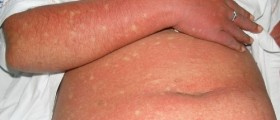
Filariasis is a rather serious medical condition that affects both, humans and animals. It is caused by a parasite of the order Filariidae (a parasitic nematode) which enters the human or animal body and inhabits their lymphatic system. Humans can get infected with only 8 species of this nematode.
Pathophysiology of the Infection
Similarly to other nematodes, Filariidae parasite's life cycle comprises several developmental stages. It is estimated that the adult female worm of this parasite may produce up to thousands of first-stage larvae. The first three stages of the parasite's life take place inside the vector (the animal, to be more precise the insect who carries the parasite) while the last two stages occur inside the human body, once the infection is contracted.
Causes and Transmission
Lymphatic filariasis develops as a consequence of infestation with one of three thread-like filarial worms, Wuchereria bancrofti, Brugia malayi and Brugia timori.
Adult parasites inhabit the lymphatic system and their presence inside the lymphatic vessels is what causes all the symptoms, signs and potential complications of the disease. The parasite may live for 6-8 years and during that period of time produces over millions of larvae. In order for an individual to contract the parasite he/ she must be bitten by a vector, a carrier of the parasite which is the Culex mosquito, an insect abundantly found in many urban and semi-urban areas, mostly in endemic islands in the Pacific.
Clinical Characteristics and Complications of Filariasis
Infection can be asymptomatic, acute and chronic. In many people filariasis is actually asymptomatic. Still, in spite of not causing any symptoms or signs, even asymptomatic infection leads to damage to the lymphatic system and may also affect the kidneys. Acute infection is characterized by changes of the skin, lymph nodes and lymphatic vessels.
Acute disease generally progresses into chronic lymphoedema, also known as elephantiasis. Complications are connected to chronic filariasis. Chronic form of the disease is in a form of elephantiasis (severe skin and tissue swelling and thickening) of the limbs as well as hydrocele (fluid accumulation). These two complications can be quite severe and rather hard to treat. It is common for the edema to affect the breasts and genital organs.
Body deformities, which result from chronic and untreatable edema, are responsible for financial hardship due to loss of income and increased medical expenses. These patients are also stigmatized by unnatural appearance of their limbs.
Patients suffering from complications of filariasis (elephantiasis, lymphoedema and hydrocele) must maintain impeccable and rigorous hygiene of the affected parts of the body and take all additional measures of precaution in order to prevent secondary infection associated with more complex medical problems.

















Your thoughts on this
Loading...